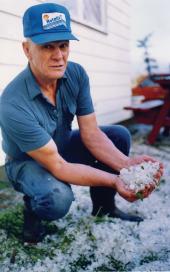
Summertime thunderstorms in Saskatchewan frequently generate hail. Hailstones are pieces of ice, usually roughly round but sometimes formed in other shapes, which grow in the strong updrafts of air (convection currents) found in the mature cells of a thunderstorm. Such cells extend well into the below-freezing levels of the lower atmosphere, 10 km or more above ground. Hail season runs from May to September. Severe hailstorms, often accompanied by strong winds at ground level, can do great damage, especially to mature crops, roofs, siding, windows, and vehicles. These storms, travelling at 30-80 km per hour, often track substantial distances across Saskatchewan, leaving long (up to several hundred kilometres) and narrow (from 5-40 km) hailswaths. Within these swaths there is usually a narrower band of damaging hail 3-20 km wide.
The largest hailstone reported in Saskatchewan, and indeed in Canada, fell near Cedoux, north of Weyburn, on August 27, 1973; it weighed about 250 gm and was 10 cm in diameter. This particular storm, and others such as the Pilot Butte storm of August 26, 1995, destroyed many crops ready for harvest. Urban areas are sometimes hit hard too: a storm with baseball-sized hailstones hit Prince Albert on August 14, 1982, producing an estimated $14 million property loss. Many farmers purchase hail insurance on their crops, in addition to general crop insurance. Crop hail-risk underwritten usually amounts to half a billion dollars or more annually; premiums collected and losses paid average $20 million a year.
Alec Paul